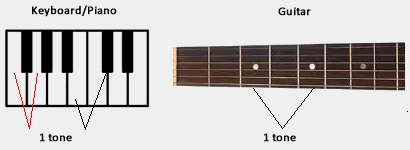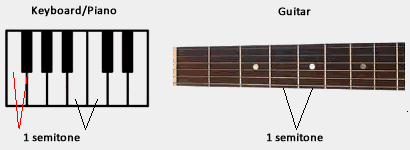Tones and Semitones
Whole & Half StepsTones and Semitones are probably one of the most important aspects of music theory as they are the foundational building blocks upon which musical compositions are constructed.
Understanding the relationship between tones (whole steps/major 2nds) and semitones (half steps/minor 2nds) is crucial for comprehending melody, harmony, scales, and overall musical structure.
These intervals form the basis for musical scales, chords, and intricate melodies, making them pivotal elements in the comprehension and creation of music.
Tones and Semitones explained
A tone is to move from one given note to the 2nd next note immediately above or below it. It is the interval equal to a whole step or major second in the standard diatonic scale.
1 tone = 2 semitones

A semitone is to move from one given note to the very next note immediately above or below. It is an interval equal to a half tone or half-step or minor 2nd in the standard diatonic scale. It is the musical interval between adjacent keys on a keyboard instrument or adjacent frets on a guitar.
1 half tone = 1 semitone

- Diatonic Semitones - a half-step (or semitone) interval between two notes that have different letter names and belong to the same diatonic scale (a seven-note scale, like major or minor).
- Chromatic Semitones - A half-step between two notes with the same letter name but different accidentals.
Double sharps or ## can also be written as x therefore F## = Fx
Double flats are written as double flats... no change, e.g., A♭♭= A♭♭
Examples Of Diatonic Semitones
E→F, B→C, C→D♭, F#→G♭, A♭→B♭♭, D→E♭, F##→G#, G#→A
Some of these examples are very tricky:
Example 1: A♭ → B♭♭ (Normally A♭ → A )
You can't go from A♭ → A because you have to change the name (diatonic)
A = B♭♭, therefore A♭ → A becomes A♭ → B♭♭... presto!
Example 2: F## → G#: (Normally G - G#)
You can't go from G → G# because you have to change the name (diatonic)
F## = G, therefore G → G# becomes F## → G# (Fx → G#)
Examples Of Chromatic Semitones
C→C#, F#→F##, A♭→A, E♭♭→E♭, G→G#, A♭→A
Example 1. E♭♭ → E♭ (Normally D → E♭)
You can't go from D - E♭ because you have to keep the same name (chromatic)
D = E♭♭ therefore, D → E♭ becomes E♭♭→ E♭
Example 2. F# → F## (Normally F# → G )
You can't go from F# → G because you have to keep the same name (chromatic)
G = F##, therefore F# → G becomes F# → F## (F# → Fx)
Accidentals
In this section, I've incorporated accidentals as they play an important role in altering notes, either raising or lowering their pitch by a semitone or a whole tone, depending on the accidental used.
- An accidental is a symbol placed in front of a note to make it sharp (#), flat (♭), or natural (♮)
- # Sharp: A sharp placed in front of a note raises it one semitone.
- ♭ Flat: A flat placed in front of a note lowers it one semitone.
- ♮ Natural: A natural placed in front of a note restores it to its original pitch position after it has been sharpened or flattened by an accidental.
- x Double Sharp: A double sharp raises a note 1 whole tone.
- ♭♭ Double Flat: A double flat lowers a note 1 whole tone.
- An accidental occurs within a piece of music in addition to the key signature.
- An accidental lasts for the duration of a bar unless contradicted before the end of the bar.
- Accidentals do not affect the same note on a different octave, unless it is indicated by a key signature.
- Accidentals are not repeated on tied notes unless the tie goes from line to line or page to page.
- Accidentals are not repeated for repeated notes unless one or more different pitches (or rests) intervene.
- An accidental must be placed before the note with the line or space bisecting the sharp(#), flat(♭), or natural.

An accidental remains in effect for the remainder of the measure.

An accidental applies to a single octave only.

Double Sharp and Double Flat
Paying attention to the various musical notations and symbols on a sheet of music is crucial for understanding how a piece should be played. These symbols provide essential instructions and information to musicians, guiding them on how to interpret and perform the music accurately.
Like any subject, whether it is a language or science, there are criteria and certain rules you need to follow. If you remember the rules and more importantly understand them, learning becomes a 'breeze'.
More on Tones, Semitones, and Accidentals
I have included the following video by musictheoryguy, just in case you need further help in understanding tones, semitones, and accidentals... great viewing.

